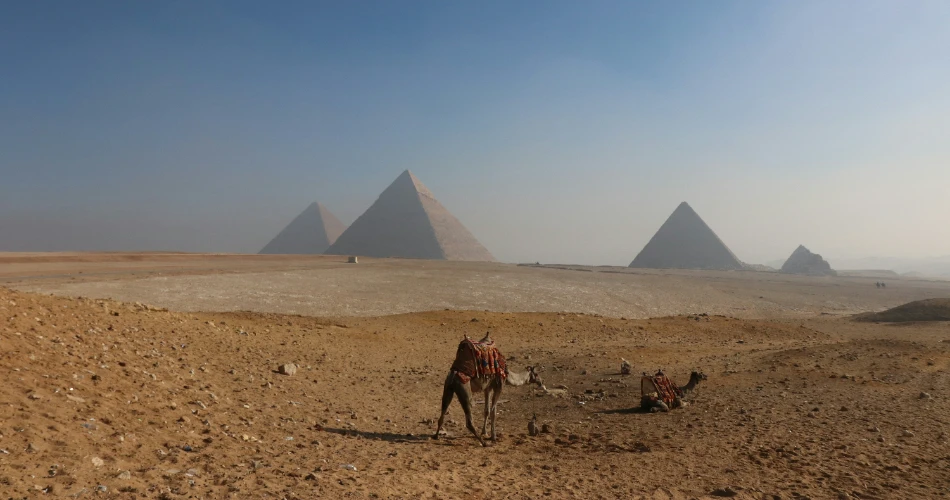10 Interesting Facts About Cairo

Discover the City of a Thousand Minarets, where ancient wonders blend with vibrant city life in a whirlwind of culture and history. Here are ten reasons why Egypt’s capital is a must-visit!
Often known as "The City of Thousand Minarets," Cairo blends a classic, historic allure with a lively and delightful environment, displaying a rich assortment of Islamic architecture, and embodying the city's predominant religion. Cairo is a cultural combination of many social classes and civilizations, delivering a cozy and inviting ambiance. In this blog, we will explore the 10 fascinating facts about Cairo that capture the magic of this lively metropolitan.
Capital And Largest City of Egypt
Cairo is the largest metropolitan in the Islamic realm and the Middle East. The Capital metropolis is perched in northern Egypt, known as Lower Egypt, situated 120 km west of the Suez Canal and Gulf of Suez. It is connected with historic Egypt because the old metropolitan of Memphis and the famous Giza Pyramid are situated on its topographical boundaries.
The Longest River, The River Nile Flows Through It
The River Nile is traditionally recognized as the longest river in the world, although recent discoveries suggest the Amazon may be slightly longer. However, the Nile remains the longest river in Africa. Flowing through Cairo, the city is situated on the east bank of the Nile and features two islands, Roda and Gezira Island, along its course. In Egypt, every aspect of life is intricately linked to the Nile, underscoring its importance to the culture and history of the region.
Cairo is Believed to be the Genesis of Mankind
The meaning of the name Cairo is translated as Victorious. Locally, it's often named “Umm Al Dunya,” meaning the mother of the realm. This title signifies Cairo's notability in the world of historic achievements. Historians assert that Cairo and the broader region of Egypt are the cradle of civilization, backed by archaeological evidence. Viewed through a modern lens, the city's historic architecture, lifestyle, artifacts, and culture reveal a society that was remarkably advanced for its time.
Second Most Populous Urban Agglomeration in Africa
Cairo's population grew rapidly during the war period, reaching approximately 2 million by the onset of World War II in 1939. Since then, the metropolitan area has experienced an ongoing increase in both its population and advancement. According to the consensus of 2021, the greater Cairo metropolis district is home to a population of 21.3 million making it the most populated metropolis in the realm of Arabs and the second largest in Africa.
Cairo Sustains, the Only Remaining Ancient Wonder of The World
Among the historic Seven Wonders of the Ancient World, which include the Colossus of Rhodes, the Hanging Gardens of Babylon, the Lighthouse of Alexandria, the Mausoleum at Halicarnassus, the Statue of Zeus at Olympia, and the Temple of Artemis at Ephesus, only the Great Pyramid of Giza still stands today in Cairo. Built during the reign of the legendary King Khufu, this remarkable structure is notable for its impressive size, intricate construction, and stunning architecture, making it among the must-visit attractions in Cairo.
Al-Azhar Mosque Is the Foremost Mosque Built in Cairo
Located in Islamic Cairo, Al Azhar Mosque is an ancient mosque built under the direction of Al Muizz Li Din Allah from the Fatimid dynasty in 970 to serve the new capital. As the centerpiece of Fatimid Cairo, it has significantly contributed to the city's identity, earning it the nickname "the City of a Thousand Minarets." As the years have passed, the mosque has undergone several extensions and restorations, displaying the combination of many architectural decors, making this mosque among the best places to visit in Cairo.
Cairo Is Home to One of The Tallest Structures Crafted by Human Hands
The Great Pyramid of Giza, still standing today, is one of the tallest human-made structures, originally reaching a height of 146.7 meters. It is part of the Giza Necropolis, which includes other notable pyramids. Constructing this pyramid took about 20 years and involved over two million stone blocks. It held the title of the tallest man-made structure in the world until the early 13th century, when Lincoln Cathedral was completed at a height of 525 feet. This legendary title lasted for more than 3500 years, making these pyramids must-see in Cairo Egypt.
Cairo Is Home To One Of The Oldest Universities In The World, Al-Azhar University
Al-Azhar University is the second largest higher education institution in the world. Established in 975 AD, it was the first major university in Egypt to offer educational degrees. Students must gain admission to pursue degrees in Islamic law and various other disciplines. Today, it remains the only institution in Egypt functioning as a modern educational establishment, continually expanding its offerings with a variety of undergraduate, graduate, and postgraduate programs.
The Oldest Structure in Cairo Is The Babylon Fortress
Cairo's origins trace back to settlements in the first millennium, including the area known as Babylon. The historic citadel was built around 30 BC after Emperor Augustus's arrival in Egypt, though the main Babylon Fortress is believed to have been constructed by the Persians in the 6th century. Located in the heart of the Coptic Orthodox community in historic Cairo, the Babylon Fortress marks the boundary between Middle and Lower Egypt, where riverboats were required to pay tolls while navigating the Nile.
Cairo Was Britain's Base of Operations
In the 19th century, during British Colonization, officials opened their base in Cairo, ruling Egypt from there. They constructed a modern transport network connecting Cairo with other urban hubs. British administration continued remotely from Cairo until World War 1, particularly from 1914 to 1918.

